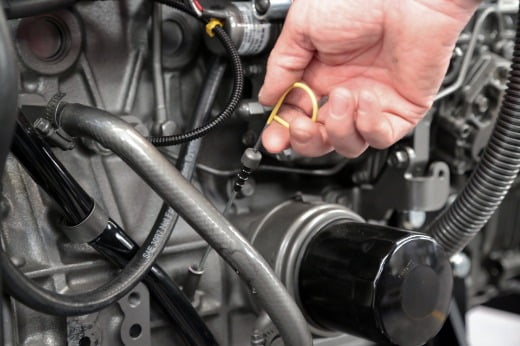What are the consequences of operating a generator in low load mode? What damage can the equipment cause? What corrective measures should we carry out?

The endothermic engines that are used in diesel generators are designed to use as much power as possible, from as little as 30% to 100% of the declared maximum power available.
The actual engine load depends on the power that the installation demands – in other words, how much power is being drawn from the generator. The engine itself and its ancillary components are primarily designed to operate in the high load or power range rather than in continuous low power load mode.
Consequences Of Operating Uninterruptedly In Low Load Mode
Operating uninterruptedly in low power load mode can lead to higher oil consumption and consequently to a manifestly greater deposit of carbonised oil or oil residue in the engine, as well as in the suction and exhaust system.
The emergence and persistence of residue has a negative impact on the functional behaviour of the engine, as well as it’s expected lifespan. As a result, maintenance tasks, and associated costs, tend to increase with units run primarily in lower power load mode.

In addition, when an engine is operating in low load mode, it cools down, which means that the fuel is only partially burned, which can in turn produce a white smoke with high hydrocarbon emissions.
Due to the low fuel temperature, the percentage of unburned fuel in the oil increases. These problems are due to the fact that the piston rings, the piston itself and the cylinder do not dilate enough to ensure a good seal. This results in the oil rising from the sump into the combustion chamber and is expelled through the exhaust valves. This means that the diesel oil passes (slowly) into the exhaust system and can damage components there.
Frequent and continued use of generator sets with power loads of less than 30% of the maximum power value can lead to the following failures over time:
Increase of exhaust smoke.
The presence of traces of fuel in the engine oil.
Excessive wear of the turbocharger.
Oil leaks in the body of the turbocharger.
Increased pressure in the gearbox and the crankcase (Blowby).
Excessive deposit of carbon residue on the surfaces of the valves, valve seats, pistons and the exhaust manifold.
Hardening of the surfaces of the cylinder liners.
If such a system exists, lower efficiency of the exhaust gas treatment system (ATS) which may activate the forced regeneration cycle of the DPF.

Recommended Corrective Measures
To avoid any incident and ensure the correct use of the generator set, Midas recommends that you avoid operating it uninterruptedly in low load mode, or that you reduce such usage to the bare minimum of time. More specifically, the use of generator sets in low load conditions for more than 15 minutes should be avoided.
During the weekly operation tests, the no-load operating time should be limited to a maximum of 15 minutes, until the battery charge values have returned to normal.
The generator sets should be operated once a year for several hours at full load to clean the engine, in other words, to eliminate the carbonized oil deposits in the engine and exhaust system. This may require a load bank. The load should be increased during the course of the four hours of the operation, from zero to full load.
If the failures mentioned above appear, along with long-term use of the generator with little energy load, operate the power generator at full load, if possible using a Resistive Load Bank before replacing any component. This is something that Midas has at it’s disposal and indeed use on all of our hire fleet regularly.
For these reasons, and unlike some “less than reputable” diesel generator hire businesses, will never over-spec a diesel generator unit. If you would like to speak to one of our team about your power requirements, please contact us here.









